The Lian Li Hydroshift LCD 360S AIO Cooler Review: Sleek, Stylish, and Lively
by E. Fylladitakis on June 28, 2024 9:00 AM ESTTesting Results, Maximum Fan Speed
Our maximum speed testing is performed with both the fans and the pump of the kit powered via a 12V DC source. This input voltage should have the pump and fans matching the speed ratings of the manufacturer. According to Lian Li, the fans included with the HydroShift 360S should have a maximum rotational speed of 2500 RPM. Our tachometer indicated that the fans were rotating at an average speed of 2490 RPM, very close to the rated specifications and consistent to each other.
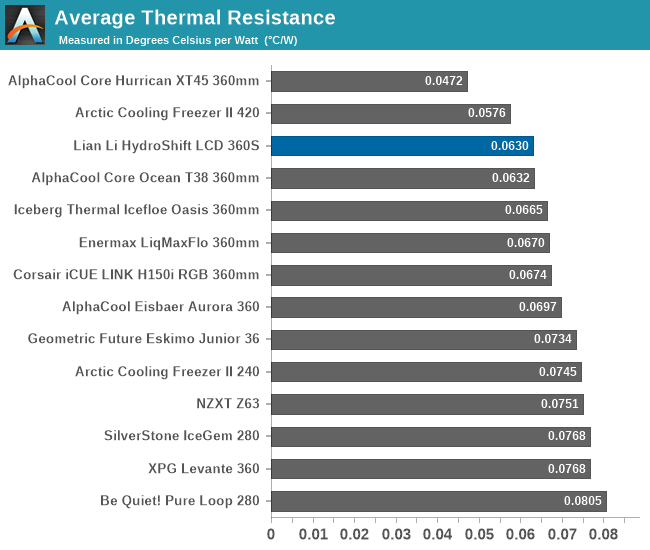
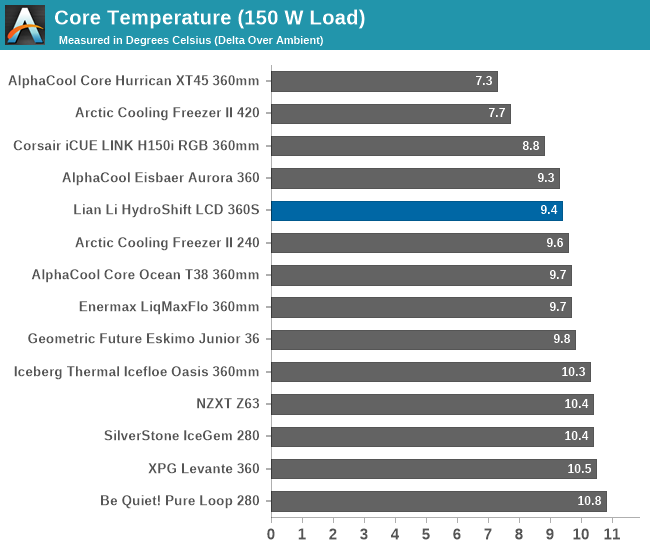
| Core Temperature, Constant Thermal Load (Max Fan Speed) |
The Lian Li HydroShift LCD 360S exhibits impressive performance across different load scenarios. At its maximum fan speed of 2490 RPM, it achieves an average thermal resistance of 0.063 °C/W. This performance ranks it among the top contenders in our charts, surpassed only by larger and more complex open-loop cooling systems. The cooler maintains its thermal efficiency consistently, even under varying demands. However, it is also important to note that the maximum fan speed is relatively high compared to similar products in the market.
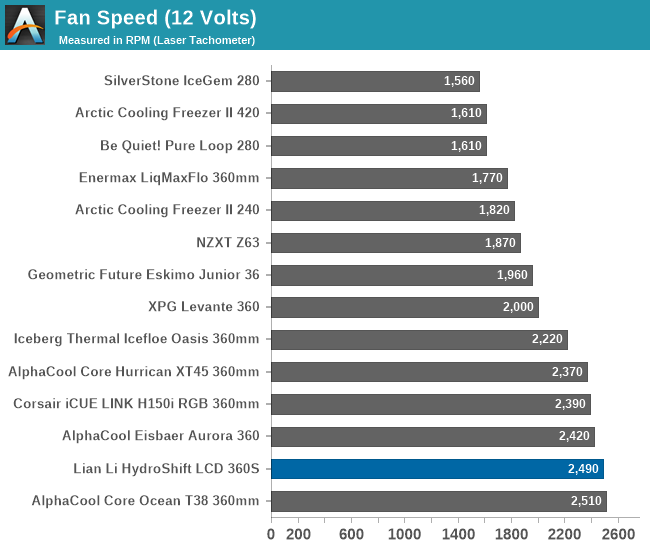
The Lian Li HydroShift LCD 360S, producing 47.1 dB(A) of noise at maximum fan speed, which is a little higher than expected even for a cooler with three high-performance 120mm fans. Additionally, the pump is powerful and can be easily heard if the fans are slowed down, contributing to an overall noise pressure level that tops our charts in the bad kind of way.
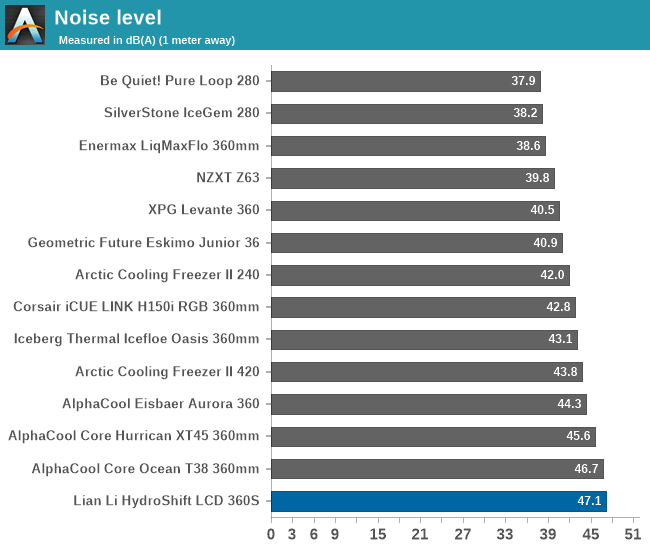
Testing Results, Low Fan Speed
Using a PWM voltage regulator, we reduced the speed of the fans manually down to half their rated speed. At this setting, the 120 mm fans of the HydroShift 360S rotate at 1250 RPM.

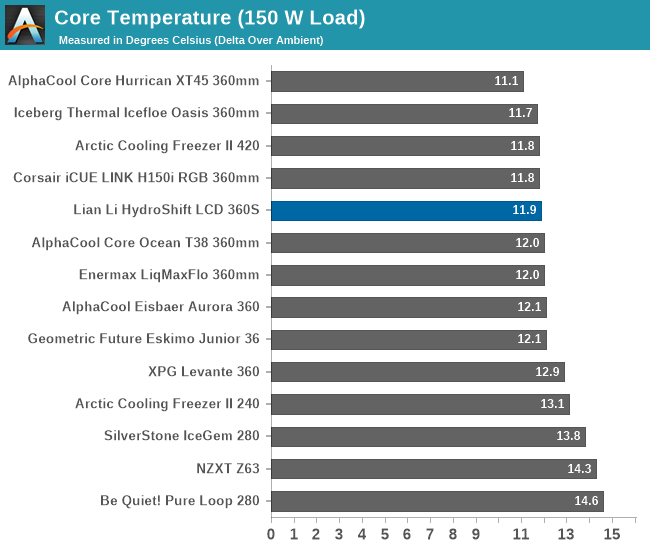
| Core Temperature, Constant Thermal Load (Low Fan Speed) |
The Lian Li HydroShift LCD 360S exhibits impressive cooling efficiency again, achieving an average thermal resistance of 0.079 °C/W with its fans operating at 1250 RPM. Its thermal performance is steady regardless of the load and the cooler is unfazed even at our highest load setting, suggesting that its cooling capacity is well beyond our testing station’s maximum capabilities. While this performance causes it to lose the top spot on our charts, it still remains one of the best performers available.

The acoustic performance at this lower fan speed is, once again, relatively poor. Even with the fans running at half speed, the cooler generates a relatively high noise level of 36.4 dB(A), positioning it as a noisier option compared to other three-fan cooling solutions. Despite this, we should remind that the HydroShift 360S offers a wide fan speed range, allowing users to adjust the fans down to as low as 200 RPM for quieter operation if desired.
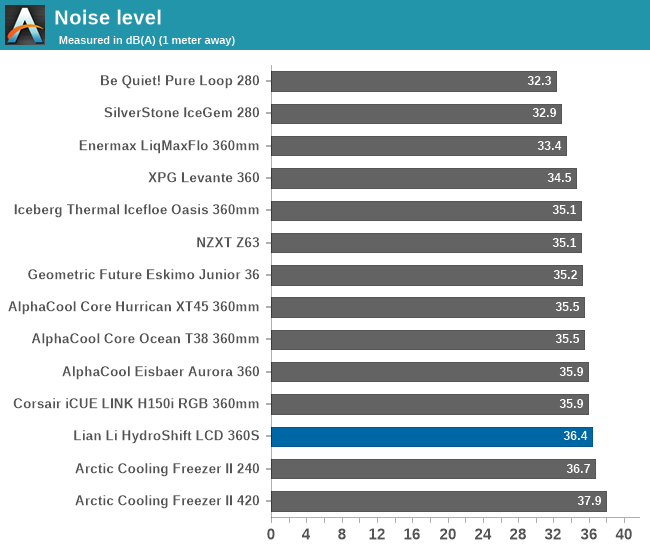
Thermal Resistance VS Sound Pressure Level
During our thermal resistance vs. sound pressure level test, we maintain a steady 100W thermal load and assess the overall performance of the coolers by taking multiple temperature and sound pressure level readings within the operating range of the stock cooling fans. The result is a graph that depicts the absolute thermal resistance of the cooler in comparison to the noise generated. For both the sound pressure level and absolute thermal resistance readings, lower figures are better.
This chart provides insightful details on the performance of the Lian Li HydroShift LCD 360S. It shows that the HydroShift 360S boasts a superior performance-to-noise ratio across its operational range compared to most competitive products, with the exception of the Enermax LiqMaxFlo. The Iceberg Thermal IceFLOE Oasis offers similar performance at low fan speeds, but the HydroShift 360S surpasses it as the load increases. While the cooler generates a relatively high amount of noise at its peak, its performance-to-noise ratio is excellent, making it a top contender in its class. We should remind that the HydroShift's fans have a very wide operational range and can operate from as low as 200 RPM to as high as 2500 RPM, providing excellent versatility to users wanting to program their own cooling profiles.


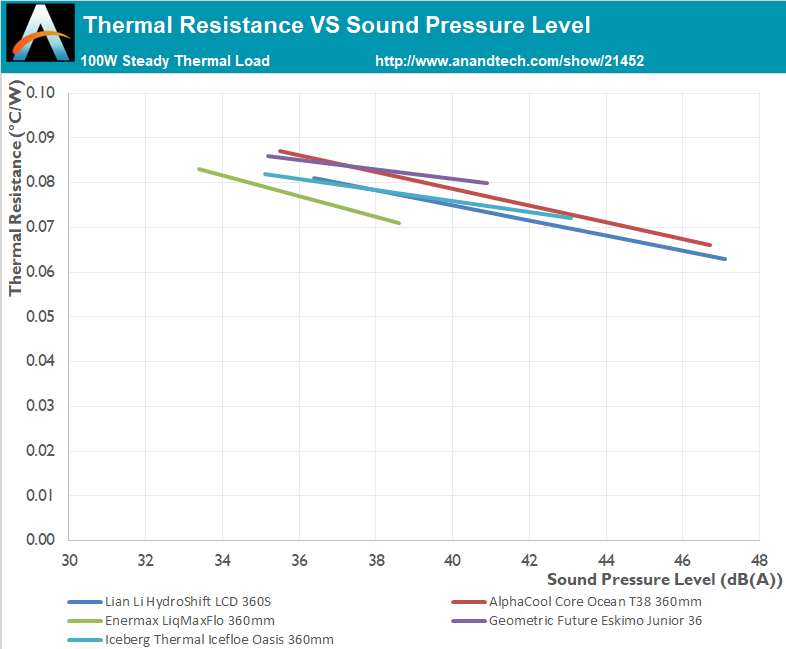








10 Comments
View All Comments
alyarb - Friday, June 28, 2024 - link
I'm so old I still have a Lian-Li PC60James5mith - Friday, June 28, 2024 - link
I customized the hell out of my PC60 back in the day. Even had one of the purple anodized variants at one point.PeachNCream - Friday, June 28, 2024 - link
"...with more than just a touch of modern flair..."I know writing is hard, but that one was like the local hair stylist trying to sell me a bottle of conditioner or some half-baked home improvement television series starving for words to fill the silence so the audience doesn't find something else to visually assault themselves with.
thestryker - Friday, June 28, 2024 - link
Do we know if this pump is an Asetek or their in house design?An AIO with a screen isn't really up my alley, but I know with the Galahad II the one with a screen was Asetek and the others were the in house design.
Eliadbu - Sunday, June 30, 2024 - link
I don't know if it's in house design, but Asetek gen 8 pumps have distinct coldplatewhich squared and has different shape and screw holes than their own stuff, by the look of this AIO it looks more like their normal and performance trinity and not like Asetek design.
GeoffreyA - Saturday, June 29, 2024 - link
I'm curious what happened to the site yesterday, all the comments being locked.Ryan Smith - Saturday, June 29, 2024 - link
We were doing maintenance, which goes a lot faster with the DB locked.GeoffreyA - Saturday, June 29, 2024 - link
All right. Thanks.Mikad - Sunday, June 30, 2024 - link
Are the first paragraphs of these recent articles AI generated? Asking because they are cringeworthy.Ryan Smith - Tuesday, July 2, 2024 - link
No. Company policy doesn't allow us to use AI writing tools. Also, AIs make for terrible tech writers.(That said, some days it's hard to write a good intro, especially when you've already written so many. Can't win 'em all, but we try!)